
On April 10, 1863, Gen. Earl Van Dorn attempted a raid on Franklin, approaching via the Lewisburg Pike. The Federal occupational force, with the aid of pounding artillery from Fort Granger, was able to repulse the Confederates.
On a hill overlooking a horseshoe bend in the Harpeth River north of the town of Franklin, Fort Granger played a major role throughout the war in protecting Federal control of the railroad and the town itself. Federal engineer Capt. William. E. Merrill designed and oversaw the fort’s construction, which began in 1862 under the command of Maj. Gen. Gordon Granger, for whom the fort is named. The fort encompassed 12 acres and was large enough to have at one point housed 8,000 men and 24 pieces of artillery. It additionally had room for a 9,000-gallon cistern, a 1,200-round powder magazine, and a supply of 70,000 rations. On April 10, 1863, Gen. Earl Van Dorn and his 28th Mississippi Cavalry attempted a raid on Franklin approaching via the Lewisburg Pike. The Federal occupational force engaged Van Dorn in a heated skirmish and, with the aid of pounding artillery from Fort Granger, was able to repulse the Confederates. It fell into disrepair after this engagement, a report from April 1864 stating that it was in a “dilapidated condition” and that “no attempt appears to have been made to keep it in proper order or repair.” During the November 30, 1864, battle at Franklin, a company from the 1st Ohio Volunteer Light Artillery positioned at Fort Granger, one mile due north of the Federal front line, and covered the area to the south and east. Fort Granger played a key role in the repulsion of Gen. Edward Walthall’s advance during the battle, Walthall stating years after the battle that his men advanced under “the most deadly fire of both small-arms and artillery that I have ever seen troops subjected to.” Fort Granger’s guns rained death upon the Confederates, the men “terribly torn at every step” by exploding shells. Fort Granger is now a park owned by the city of Franklin and is very near Pinkerton Park. Admission to the park is free, and visitors can view the original earthworks and trenches. The fort and the attached walking trail provide numerous picturesque overlooks of the city of Franklin.
Tools
Key Facts
- Played a major role in protecting Franklin and nearby railroad lines
- Encompassed 12 acres and housed 8,000 men and 24 pieces of artillery. It had room a 9,000-gallon cistern, 1,200-round powder magazine, and supply of 70,000 rations.



